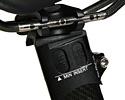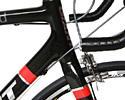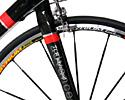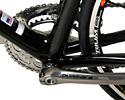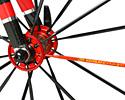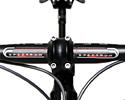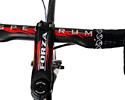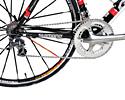
Recently on Cyclingnews.com |
On test: Giant TCR Advanced LE, April 27, 2006
The TCR Advanced LE is the latest and greatest of Giant's road bikes. The full carbon frame features an integrated seatpost, which sets it apart from most others. Cyclingnews' Jeff Jones took it for a spin around Heffron Park (and a bit further).

|
Producing four million bikes a year, Giant is aptly named in the cycling industry. The Taiwanese-based company has also been one of the forerunners of the carbon craze that has dominated bike building for the last 15 years, and is showing no signs of stopping. Its latest creation is the TCR Advanced LE frame and fork, featuring an Giant's first integrated seatpost design, and is the same frame that is used by the T-Mobile team.
Cyclingnews (well, me) was given the opportunity to test this frame over the 2005/2006 summer season in Australia. It was built up into a complete bike, specced with Dura-Ace, special edition Mavic Ksyrium ES wheels, Deda composite bar and stem, and Vittoria tyres. I managed to crank out just under 5000 km on it, and raced it numerous times at Heffron Park, Sydney's tough, technically challenging criterium course.
The frame and that seatpost
The TCR Advanced LE frame looks like a cross between a road and a time trial frame, with its aerofoil-shaped 4cm-deep seatpost the obvious standout. It stands out even more because the frame is built to Giant's compact specifications: after cutting it to size, I still ended up with 25cm of seatpost showing.
'What's all this about cutting?' I hear you ask, as the colour drains from your cheeks? Well, that's both the good and the bad about having an integrated seatpost. You do have to tailor it to your correct saddle height using a hacksaw and a tape measure. In fact, it's preferable if your Giant rep does it for you while you are safely out of the room. The rule is, "measure twice, cut once", because if you get it wrong, you could be in trouble.
Fortunately, Giant does give you a bit of freedom after the cut, as you can (a little crudely for my tastes) tweak the saddle height with 10.0mm, 5.0mm, and 2.5mm aluminium spacers. I would have preferred to be able to adjust it to within 1.0mm, but Giant told me that they couldn't make spacers that thin, and suggested I file down a 2.5mm spacer to fit. Bit of a pain, but there may be spacers of different sizes available in future. For the record, I ended up using a 5.0mm and 2.5mm together to find a good saddle height.
I was also a little disappointed in the single-bolt seat clamp, which sits on top of the seatpost. The first few times I adjusted the fore-aft position of the saddle, I found that it slipped back by the end of the ride because I couldn't get the bolt tight enough. This was improved when I lubed the nut and thread, but it still moved back a centimetre after a couple of months riding. I feel that a two-bolt clamp would alleviate this problem.
On the plus side, the integrated seatpost improves the aerodynamics of the frame, as well as eliminating any possibility of seatpost slippage, as the spacers, if any, will all be under compression, and the saddle has no possibility of slipping down. Giant also claims it reduces weight and increases rigidity and stability.
As for the rest of the geometry, the Advanced LE comes in five sizes ranging from XS (51.3cm effective top tube) to L (58.5cm). Mine was an M-L, which had a 57.0cm top tube, 16.0cm head tube, 98.5cm wheelbase, 40cm chainstay length, 72.5° seat angle, 73° head angle, and the ground clearance from the centre of the bottom bracket was 267mm. It's an interesting geometry, with a tight wheelbase and compact frame, offset against a slightly conservative seat angle.
The frame and fork are made out of TCR Advanced T-800/T-1000 composite carbon fibre. The frame is "3G jointless monocoque", Giant's straightforward way of saying that there are no bonded carbon tubes in this frame. Providing it's done right, this has the obvious benefit of increasing strength and stiffness while reducing weight. The fork is a composite one piece job, with a 1 1/8th inch ahead steerer. Its bottle cage bolts are set fairly low, and the frame also has a few drainage holes to let out the rain, which always seems to find its way in more easily.
The colours are typically subdued: glossy carbon black with red/silver bands.
Components and finishing kit
As mentioned, the TCR Advanced LE was specced with Shimano Dura-Ace 10 speed, with the exception of the wheels. The chainrings were the standard 53/39, while the rear cluster gave me a wide enough range between 12 and 23 teeth. I'm not powerful enough to use an 11 in a sprint, especially if it comes at the expense of another hill climbing gear. Ideally, I'd have a 12-25 and lose the 18, but beggars can't be choosers.
A full review of the Shimano Dura-Ace group was done by Anthony Tan in 2004, and can be read here. I'll limit my comments to saying that it worked as well as any other Dura-Ace group I've tried, with a little adjustment needed from time to time. I found the shifting to be light but accurate, and the braking to be very firm.
As always when I bring down a new toy to Heffron to race on, I got plenty of comments on this bike. Most of them were about the seatpost, but a fair few also noticed the special edition Mavic Ksyrium ES wheels. Introduced to commemorate the 10th anniversary of the Helium wheelset, these Ksyriums are a lighter version (1485g/pair) of the Ksyrium SL, with a 18 hole carbon fibre front hub, 20 hole aluminium rear hub, and a lone red spoke on each wheel, in deference to the Heliums. I've always liked Ksyriums, as they are a robust, all-round wheelset, sufficiently aero to give you an advantage over normal wheels, without compromising their handling too much. But I didn't notice any difference in feel between these and other Ksyriums.
The wheels were equipped with Vittoria's Revolution KXS reversible tread tyres. As the name implies, you can flip these tyres inside out to get an alternative tread: a slick for dry conditions, and a grippier one for wet conditions, with different compounds for each tread. A nifty idea, because it allowed me to swap the treads after I'd worn one side out after 1500 km, and I finished up with 3000 km of wear out of them.
But, I did not like the way these tyres handled at all. I did not overinflate them, and yet I could feel every rock and every bump, and they were particularly skittish around corners. I did puncture a few times on them, and when I changed them for a set of Continental GP4000s, I noticed a world of improvement. Finally, the bike stuck to the road!
Turning to the Deda bars and stem, again the theme was all carbon, all the time. The stem was a Deda Forza (12 cm), which I flipped up to give me a bit higher position. The bar was a 31.7mm O.D. Spectrum (46cm outside-outside), drop 142mm (c-c), reach 86mm (c-c). The tops were enlarged to enable a more comfortable grip while climbing. I noticed the stem/bar combo was a little flexy when leaned upon, but it was not something I was too concerned about. I was more concerned about tightening the allen key bolts into carbon, as it's not something you want to overdo. A torque wrench is handy in this case.
Finally, the Advanced LE came with Selle Italia's SLR Kit Carbonio saddle, a lightweight 140g carbon, leather and titanium job. These are very popular saddles, although in the past I've never managed to get comfortable on one. I was therefore pleasantly surprised to survive on it for two months without any undercarriage issues.
Without pedals, the bike tipped the scales at 6.92kg, nice and close to the UCI limit without cutting it too fine. David George's Lightweight wheel equipped rig that he used to win the Tour de Langkawi would have been close.
What can you expect to pay for all this? $AU8500 was the price tag on our model, which is available in its current spec only in Australia. In Europe, the closest you'll come is the TCR Composite Advanced Team ISP (same frame, but with Shimano wheels, Deda Newton bar and stem, and Continental GP 4000 tyres), which goes for €5,999. Or you can buy the frameset on its own for €2,499.
On the road
One thing I like about doing bike tests is that every bike feels a little bit different, and some a lot different. I've never ridden a Giant before, and I guess if I had to compare, this handled a lot like the Canyon F10 I tested last year. Jumping on it, and you immediately notice how lively the front end is. It responds quickly to steering adjustments, and took about a week to get used to. By the same token, riding no hands was never a problem.
Continuing on with the handling theme, I should point out that all the racing I did on this bike was at Heffron Park in Sydney. It's a purpose-built criterium course, 2 km long with eight corners per lap, and it's one of the best courses for testing a bike's handling that I know of. As mentioned previously, I didn't fully appreciate the cornering characteristics of the Advanced LE until I swapped the tyres over to something a little stickier. Once the back wheel stopped skipping around, I had a little more confidence.
What I noticed about this frame was that it had a very tight cornering potential, in particular at speeds of under 45 km/h. You could start a corner on the inside and still exit inside of centre, a very handy thing to know. It was also easy to change your line, if necessary.
Again, in the context of criterium racing, my personal preference is for a slightly raised bottom bracket, so you can continue pedaling through most of the corners: The TCR Advanced LE's 267mm is by no means high. With a set of 172.5mm cranks and old-style Time Impact pedals, I still managed to scrape my pedals three times - not disastrously, but enough to make me and others think. On each occasion, I was taking a corner with a tighter line than I normally would, so maybe it's another thing to get used to.
On the open road, handling issues like the above aren't nearly as noticeable. The bike's light weight and stiffness made it a gem to sprint and accelerate on. When putting power to the pedals, I never noticed any sluggishness, even on tired legs. On one of my first races on it, I managed to win a two man sprint fairly comfortably, which shocked me. I also found that my attacks tended to have a bit more venom in them. Either that or everyone else was tired.
Climbing, whether in or out of the saddle, was fast, as expected. Knocking over 2 kg off my normal rig is noticeable, not so much in the suffering aspect, but more in the reduced times. I did break a couple of training climb records on the Giant, including some set on a light bike, so I was satisfied that it was up to the task. It provided a nice, stable position to climb in, and I wasn't uncomfortable or moving around in the saddle.
I also appreciated that despite its stiffness, the frame did not give a harsh ride at all. I wouldn't have survived for that long on an SLR saddle if it had! My rides typically didn't extend beyond four hours, and even these were quite limited. Ideally, I would have preferred a narrower and shallower drop handlebar for more comfort, but survived pretty well on the Deda Spectrum.
Conclusion
Overall, despite a few quirks and tweaks, I was quite happy with the Giant TCR Advanced LE. It's a stiff, comfortable, and fairly aggressive handling bike, and it grew on me over the course of the rest. I do like the idea of the integrated seatpost and can see the advantages of it. But, I do think you need to be given enough leeway to micro-adjust your saddle height: changing saddles, shoes/pedals, or on-selling the bike will all require this sort of fine tuning.
Suggested retail price: AUS$8,500 (In Europe, a similar bike sells for
€5,999, while the frameset on its own is €2,499)
Weight: 6.92kg (without pedals)
Pro: Weight, stiffness, aerodynamics
Con: Care needs to be taken with ISP, single bolt seat clamp, handling
takes some getting used to
Cyclingnews Rating: ![]()
Full specification: Giant TCR Advanced LEFrame: TCR Advanced T-800/T-1000 composite carbon fibre with 3G
jointless monocoque mainframe and integrated seat post Cranks: Shimano Dura-Ace, 53/39T, length 172.5mm Levers: Shimano Dura-Ace |
MSRP: AUS$8,500Wheels: Mavic Ksyrium ES special edition Stem: Deda Forza composite 31.7mm Pedals: Not included More information: Giant's website |


